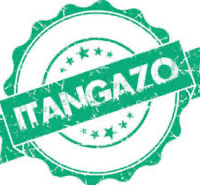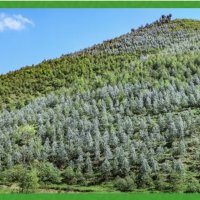Most people might not know that rhino horn can be harvested and regrows at about 20 centimetres, annually. The removal of rhino horn is generally associated with poaching that involves first killing the rhino and then mercilessly chop-off its horn, leaving an unsightly and bloody hole on its head.
When the world’s biggest rhino breeder, South Africa-based John Hume invited some South African journalists to his rhino breeding ranch this week, to witness rhino harvesting they all said it was their first time to witness live rhino horn harvesting.
The rhino harvesting work started at 7am. After the rhino horn harvesters at Mr Hume’s ranch, the Buffalo Dream Ranch (BDR) had travelled about two kilometres, five white rhinos burst into sight surrounded by two rhino camp masters on horseback. Their job involved restricting the movement of the rhino targeted for horn-harvesting so that darting would be easy. Suddenly, the sound of darting gunshot rang in the air and a white syringe could be seen stuck on the bum of the targeted rhino. After darting the rhino with great accuracy, the BDR Wildlife Veterinarian, Dr Michelle Otto ordered the car she was in to stop and so did the others behind it.

Sedated rhino before horn-havest
It was time to wait for the rhino to be sedated. Once hit by the dart the rhino kept running with the other rhinos. About three minutes later the darted rhino became visibly sedated. It started moving very slowly like it was stuck in the mud. At this stage Dr Otto swung into action again. This time not to dart the rhino but to help the sedated animal lie gently on its feet. A team of rhino rangers involved in the rhino harvesting work jumped off the back of the four bakkies (small trucks), followed by journalists whose cameras kept on rolling till the horn was harvested.
The rhino horn harvesting process took three minutes only. The rhino did not feel any pain. There was not even any blood on the horn as Mr Riaan Calitz the BDR Section Manager harvested it, using a reciprocating saw while one staff member was pouring water on the horn to prevent any heat from being generated by the saw. Then the BDR General Manager Mr Johnny Hennop measured the weight, length and circumference of the horn while other staff members took blood samples for DNA records of the rhino that would be sent to the Pretoria-based South African Genetic Laboratory.
Moments later, Mr Hennop packed the horn so quickly and almost secretly. It seemed to be reminder that we were witnessing a rare harvest of one of the world’s precious commodities – the rhino horn.
About a minute after the harvest the rhino was back on its feet, broke into a trot and quickly reunited with its group. No pain, no blood and most importantly, no killing of the rhino. The harvest continued perfectly as it started until 18 rhinos had their horns harvested.
“We can harvest rhino horn after every two to three years,” said John Hume. “Some of the rhinos have had their horns harvested up to five times.”

Meticulous and pain-free harvest
One needs to apply to the Government for a permit before harvesting rhino horn. Two officers from South Africa’s Department of Environmental Affairs supervised the rhino harvesting process.
Rhino horn harvesting is not very expensive without the use of a helicopter. The harvest at Mr Hume’s ranch involved the use of bakkies (small open trucks) at a total cost of up to US$320 per rhino.
“We harvest about 600 horns annually and are currently enjoying a population growth rate of 200 rhinos annually,” said Mr. Hume.
However, Mr. Hume is a unique harvester. While most harvesters particularly farmers, harvest knowing when and where exactly they are going to sell their produce, Mr. Hume harvests with hope that one day he will be allowed to sell his rhino horn as permits to sell rhino horn “are the most difficult thing to be issued with by the Government.”
“Now we prefer the new term as rhino harvesting not dehorning because it better portrays what we do – we save the rhinos’ lives not the horn,” said Mr Hume. “To save the rhino you have to harvest and sell its horn but I am currently a hopeful harvester of rhino horn as I currently can’t trade in about 7 000 kilogrammes of rhino horns that I have harvested so far. Unfortunately, hope does not pay for the staff salaries, rhino security, buy supplementary rhino feed and the other million expenses that I have to meet.”
He said that it was taking long for him to get permits from the Government to sell his harvested rhino horns.
In September 2017, Mr. Hume attracted local, regional and international media attention with his world first legal online rhino horn auction.
“The Government’s delays to issue permits to the buyers unfortunately resulted in them asking for their money back and the exercise did not bring the much anticipated success,” said Mr. Hume.
Mr Hume said his “primary purpose is to save the rhino from extinction” and not only to “profit” from the sale of horn. Therefore, the income from the rhino horn sales is very important to his continuing rhino conservation efforts, as it would be used to over security, veterinary, rhino supplementary feed, staff, range expansion costs.

John Hume the world’s biggest rhino breeder
Meanwhile, Mr Hume is currently paying about US$160 rhino storage fees, excluding insurance. His annual rhino security system bill is about US$2 million, excluding the salaries of rangers and other staff. He recently purchased an over US$3 million security system through a loan that is not fully paid yet. However, Mr Hume draws a lot of comfort from this security system that can spot poachers or trespassers while they are half-a-kilometre away from his rhino ranch fence boundary.
“Last week we spotted an intruder while he was 500 metres away from the ranch, said Mr Hume. “If a poacher gets in and shoots a rhino he would be arrested within minutes because the entire area is covered by radar security system.”
Mr Hume has so far spent about a U$100 million lifetime fortune on rhino breeding. Therefore, he cannot wait till the Government issues him with permits to trade in his approximately 7 000 kilogrammes of stockpiled rhino horn.
At the same time we keep positive,” said Mr Hume who recently offered to share his white rhino breeding skills with Southern African rural communities so that they too can contribute to rhino conservation. “Our white rhino project has an excellent breeding and protection rate. Over the past 10 years we have had an overall 9.7% population growth. I believe that this project is a blueprint for restocking our national wildlife reserves when they have done away with poaching crisis and even to restock Africa’s rhino populations.”
About the writer: Emmanuel Koro is a Johannesburg-based international award-winning environmental journalist who has extensively covered conservation and development issues in African countries.
The Express News










